Cassoni. Paintings-boxes is curated by Marie de Brugerolle, invited by Anne Barrault. The gallery presents nine artists, from various generations and backgrounds, a selection of works, most of them never shown in France or produced for the exhibition.
In line with the reflection on post-performance painting*, Marie de Brugerolle imagines what the cassone would be today. Content and container are upside down, in a series of forms and uses. At the heart of the theme: painting as the object of love, a proof, a pledge. Let’s quote Marcel Duchamp: “J’ai pris une femme, c’est commode”, i.e. I have taken a wife, it is a chest of drawers.
In French the word « commode » has a double meaning, as an adjective, it means “easy” and as a “noun”, it means a piece of furniture: « a chest of drawers”. It is the first household piece of furniture which origin were the Cassoni, wedding chests, both objects of exchange and of parade.
The exhibition invites us to wonder about the economy of love. What would be our trousseau today?
The starting point is a reflection on 3D painting, as a transitional object, beside the imaginary plan of an icon: a multidimensional volume which calls our body, performs stories, not only a painted surface stretched on a frame hanging on a wall, but a polysemic and polymorphic one. Then the painting becomes the start or the destination of an action: a volume on a shelf, on the ground, in a showcase. A painting-box is a painting with a back, a tondo, which can be the lid, a desk that would be a chest, and the cabinet of an amateur, a puzzle of identities of different thickness…
The Cassone: an object to think painting on a larger scale.
The Cassone is the emblematic object of a material and symbolic exchange. It materializes the passage from “a household”, a family line to another, in the shape of a set of material and immaterial goods. The passage from being a fiancée to being a married woman, in so short a time, was illustrated by Duchamp’s the Grand Verre, La Mariée mise à nue par ses célibataires, mêmes. But here what matters is the shape of the box, which contains and shows the painting in its forms and uses. From surfaces and depth effects, patterns as much structural as decorative, as with Nathalie
Du Pasquier, or Jordan Derrien. The painting as an object to be put down, to be set, to be hung, carried, opened. Erotism is as much in the pattern (Manon Vargas, Tiffany Pui Chow) as in the possible opening (Cédric Esturillo). An object of desire, which can be unclipped and unfolded (Nathalie Du Pasqueir’s Cassone di Lisboa), or looked at through the showcase (Alex Heilbron and Niko Chodor).
A Venus guides us…the Venus from the painting under the lid of the cassone.
The Venus of Urbino, by Titian (1538) was torn from a cassone. Note that the panel allows us to consider its size to be that of a full-scale body (119×165 cm). The erotic scene belongs to the suggestive vocabulary of the first nudes found in these large wooden boxes, called cassoni after G.Vasari. Their usual names were Forzieri, which literally means “chests”.
(…)
Ostentatious objects, carried from one house to the other, a few days after the wedding (civil and religious), the Cassoni are displayed half-open , in order to exhibit their contents and the rich dowry. They are looked at, for all to see, and attest of the alliance of two families. The parade of the Cassoni is a “triumph” which crosses the city, from the bride’s house to her husband’s. It is a social act, which let the news to be known by everyone. What is personal becomes public. This staging and visual demonstration is equal to a kind of public promulgation of a legal act. Marriage is mainly the share of property, in order to build up the parts of an estate. The “conjugal duty”, which aims at procreation, is a way of making the common property grow. The female is, strictly speaking, a “transitional object”, which materializes a symbolic exchange (the alliance between two clans), and is, actually “ commodities”, or goods. This is pointed out by the Napoleon Civil Code, which treats the wife as a child, who cannot work or have her own bank account without her husband’s authorization. A wife is not a “subject, she is an “object”.
I thought of marriage as a question of exchanged objects, of the female as a tribute, a pledge of peace between clans, peoples, and castes. This objectification of marriage, which is first of all an exchange of property, before being mutual consent, in the guise of love, has become a topic of discussion. Ostentation and parade, the performing act itself in the statement “ I marry you”, and the public staging of the bride as a commodity to be exchanged, have made me think of this parade as a post-performance, of which the city, the “polis” was the setting.
(….)
** Post-performance painting is a chapter of the Post-performance future ’s research. Invented by Marie de Brugerolle, it focuses on the impact, legacy and development of performance upon visual arts. Post-Performance painting investigates painting as a source or destination of performance. Its making, acting and setting are envisioned as part of the process and extension of its parergon.
Marie de Brugerolle, January 2022 (excerpts from a book in project.)
Pui Tiffany CHOW
Born in 1987, Hong Kong. Lives and works in Los Angeles.
The painting upside-down : Under the cover.
Pui Tiffany Chow is an artist from Hong Kong, who lives and works in Los Angeles.
Each piece has its own structural logic and thwarts the style as a mark of recognition.
It replaces the notion of historical filiation or quotation with the one of a shameless and debt-free borrowing. One likes it or not. Her practice un-hierarchizes styles. One recognizes some motifs present in great historical paintings, Mannerist or Baroque ones, whose acidic colours punctuate some incisive erotic scenes. The hybridization of a gloved hand such as the one of Michey, but “after Guston”, or a feet whose fleshy red texture evokes the incarnat surface of a tongue, contrats with the matt white of a forearm that seems to be left in primer (gesso) or flocked.
Tin Dot is a tondo painted on both sides. The fact that the back is painted, but in a more rapid manner (quickly spray-painted motifs, dots, welts), reinforces the notion of object-painting. A tondo or a lid?
Round, this work evokes the “cookie boxes », which are blue metallic cake boxes kept by female workers in Hong Kong. Hidden under their beds, often placed in collective dormitories, the round boxes have a new, private and intimate use. Women workers put inside a personal, “non-household”, kitty. This “anti-dot” is intended to buy things the husband does not offer or which are not part of the “common good”. It is also a way to save some money in order to dream of independence, or even to run away. This constitutes a twofold economy: on the one hand, subtracting the result of a singular work from the common pot, and on the other, building the means of a personal autonomy.
Lastly, it allows the constitution of a “personal” fortune which places women’s work in a condition of emancipation. The latter operates by withdrawing from the gaze, the (re)construction of an intimate property, not devoted to the family or submitted to the tutelage of the patriarch or the employer. Furthermore, the shape of the tondo evokes the convex or concave shape of a mirror, such as the one in The Arnolfini Portrait, painted by Van Eyck. The painted figure, coiled in a pose of both unveiling and exhibition, underlines the double scopic impulse: hiding and showing in one gesture. This is the one of the “pudica”, which consists in hiding the model’s sex with her hand. The curves and counter-curves of the female body seen from above play with a plurality of viewpoints.
The one of a look above but also of an intimate, loving and also cinematographic approach. The cookie box is a box of sweets which becomes a goal. It is the eye of the camera, the keyhole, that the rounding replays. The Tin Dot is an upturned
lid, which marks a point on the wall and a possible breakthrough beyond the surface, that of the materiality of painting, as a canvas stretched on a frame, and an invitation to return and go beyond the definition of a medium limited to its support or to re-presentation. Tiffany Pui Chow offers us a poisoned gift in the sense that its tasting induces a work of looking which is not only that of the immediate satisfaction of a curiosity.
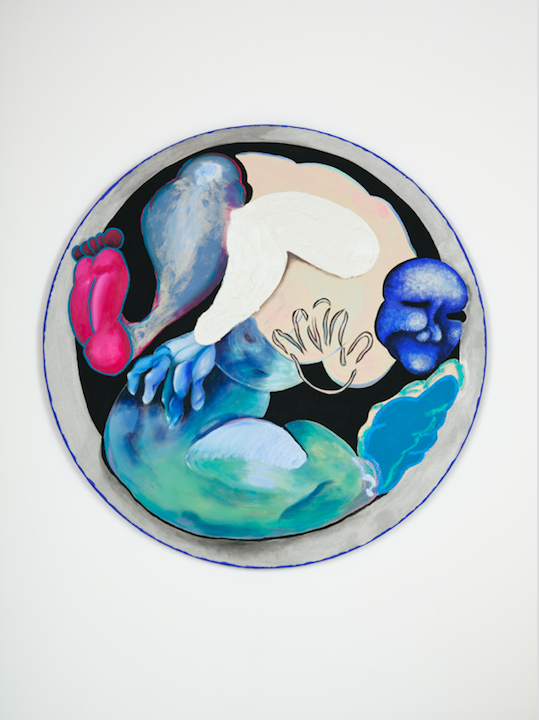
Pui Tiffany Chow
Tin Dot, 2021
diameter : 114,3 cm
//////////
Pui Tiffany Chow
Born in 1987, Hong Kong. Lives and works in Los Angeles.
She moved to the US to escape the mounting pressures imposed by mainland China after the Handover from the British government. She now lives and works in Los Angeles. Pui’s practice centers on drawing and painting, with canvases typically five-feet square or larger. Her work is a pastiche of different forms, feelings, and styles – a confluence provoking feelings of alienation and disorientation: like the experience of a new sensation; of being somewhere unfamiliar, learning a new language, being in a liminal space, in a constant state of becoming.
Figures in her work operate as vehicles to ferry the viewer from the identifiable to the unknown, presenting forms we can recognize but in a state of becoming, or breaking, or both. Formally they also serve as vessels for moments of abstraction, incorporating a wide color palette in a diversity of marks, serving to disrupt the forms. Her work is constantly investigating the relationship between western and eastern historical paintings in the context of contemporary painting.
Niko CHODOR & Alex Heilbron
Behind the window, recomposed identities. Cassoni-Passport to a new life.
Niko Chodor, lives and works in Los Angeles after studying in Düsseldorf.
As a surveyor, Niko Chodor explores cities and questions the substructures that make up the urban landscape. His guide to Düsseldorf based on his personal selection of bars, small restaurants and cafés (Everyhting I want to Eat in Düsseldorf) is a collector’s item. Composing soundscapes and working across disciplines, Niko Chodor also created and directed with Alex Heilbron, Riviera Parking in Santa Barbara, which hosted several projects during the Covid confinements.
For him, art is not a question of objects but of language that questions individuals and society. By analyzing and deconstructing motifs such as the grid, through its presence in architecture, public buildings and administrative documents, Niko Chodor attempts to produce an alternative discourse.
Alex Heilbron, lives and works in Los Angeles and Santa Barbara. She created and directed Rivieira Parking in Santa Barbara with Niko Chodor. Alex Heilbron’s work focuses on how the female body, in its physical, psychological, political and cultural aspects, is perceived in public and private spaces. Themes explored by Alex Heilbron include play and retention as forms of resistance to expectations of progress and productivity. Heilbron received her MFA degree from the University of California, Los Angeles in 2020 and studied at the Kunstakademie Düsseldorf from 2014 to 2017. Her most recent solo exhibitions include Time and Intent at Meliksetian Briggs, Los Angeles, High Shame at Hiestand Galleries, Miami University, Oxford, OH and Scent Description for a Young Woman at Ashley, Berlin.
Both artists share a critical engagement with the modernist grid and tile patterns, both in art history and in its persistence and uses in public settings and institutional documents.
For Cassoni. Painting-Boxes, Niko Chodor and Alex Heilbron create for the first time a four-handed work, Status or Benefit, which brings together two paintings with composite motifs. These are derived from various elements: administrative documents, visa procedures, identity papers, related to the process of getting married as a “non-citizen” in the United States. The two canvases of different thicknesses are held together by a golden frame. Nationality, displacement, as well as marriage and permanent residence underlie the piece.
The work uses the specific bureaucratic language of immigration forms and documents in the process of obtaining permanent resident status for the United States of America, and also evokes the tile floor of the Santa Barbara County Courthouse, where the artists got married in 2019. This building is in the Spanish Colonial Revival style, designed by William Mooser III and completed in 1929. Architect Charles Willard Moore called it the “largest Spanish Colonial Revival structure ever built” and the perfect example of Santa Barbara’s adoption of the Spanish Colonial style as a civic style. The patterns of streaks, stripes, eagles, stars and fleur-de-lys combine and confront each other, and refer to the flags of the United States of America, the European Union, Germany and Canada, the artists’ home countries.
Real etymological symbol, the work performs by its golden frame the civic union of two people coming from different countries. The wefts of administrative documents replace the coat of arms.
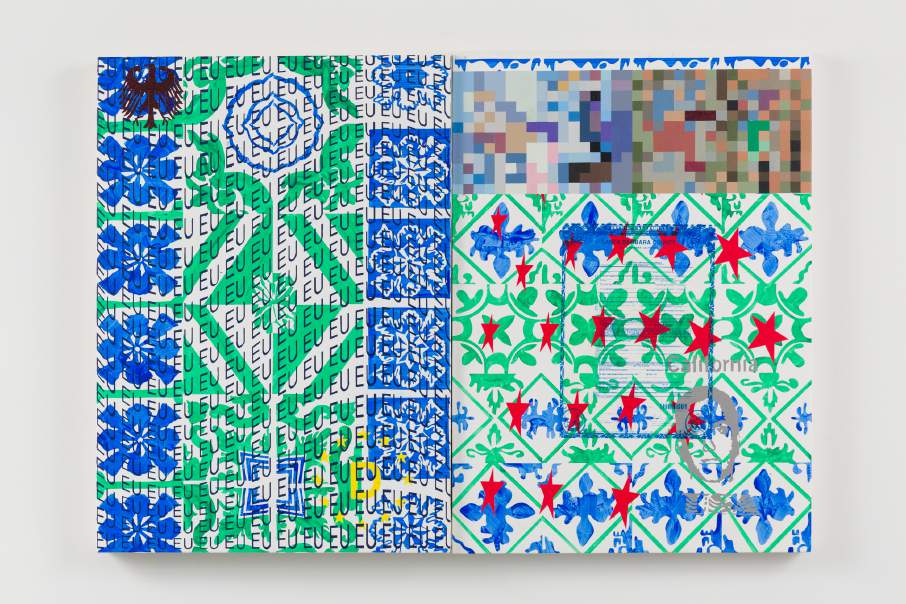
/////////
Niko Chodor
Born in 1992, Düren. Lives and works in Los Angeles.
Niko Chodor is a multi disciplinary artist that lives and works between Los Angeles and Santa Barbara. Chodor graduated in 2018 from Kunstakademie Dusseldorf and has participated and shown in various international exhibitions. His work combines representations of memory, cultural fragments and personal experiences through sampling and subverting both images and texts. This exposes the dysfunctional aspects of our contemporary society in terms of information circulation and architecture when framed within a globalized, neo-liberal consensus, and extends into structural rethinking of our designed reality.
Alex HEILBRON
Born in 1987, California. Lives and works in Los Angeles.
Alex Heilbron received her Bachelor of Fine Arts in 2009 from the San Francisco Art Institute, and studied at the Kunstakademie Düsseldorf from 2014-2017. In 2020, she was awarded her Masters of Fine Arts from the University of California, Los Angeles.
Heilbron has exhibited both nationally and internationally. Most recent solo exhibitions include High Shame at Hiestand Galleries, Miami University, Oxford, OH and Scent Description for a Young Woman at Ashley, Berlin. Group shows over the past few years include exhibitions at LAXART, Los Angeles. Moscow Museum of Modern Art, Moscow, Cosmo Sports, Düsseldorf, Good Forever, Düsseldorf, Contemporary Fine Art, Berlin and Unit/Pitt Gallery, Vancouver. In 2019, she won the William and Dorothy Yeck Purchase Award and the Helen Frankenthaler Scholarship in 2019 – 2020. Heilbron lives and works in Los Angeles.
Jordan DERRIEN
Painting through the door of the cassone. Depth of the surface, painting in relief, painting in a chain of actions.
Jordan Derrien lives and works in London. For several years J. Derrien has been confronting the creative processes of writing, performance, curating, through narrative modes, the deconstruction of contemporary myths.
In his work, the artist develops a permeable and reversible relationship between the interior and the exterior, the similar and the identical, the public and the private. Sometimes it takes the form of writings or conversations, as an extension of her studio practice. Plays of mirrors, scale and fiction are created from chessboard, repetition and loop motifs.
Jordan Derrien’s three paintings belong to a body of work begun in 2020. Black and red series, these works combine recuperated elements, wood scraps, recut and fixed fragments. The undercoats and pattern combinations are made from found fragments. The varnished panels have asperities, like the handles of a cupboard door. Fragments and debris are stuck on the surface, showing its heterogeneity. The red lacquer, which recalls the art of lacquer, is a metal or car body paint, not the traditional resin. It is applied in such a way as to leave traces, revealing the roughness of the raw materials under the gloss. Let’s go climb on the Chamberlain, 2020 is an example of this hybrid work, between high relief and volume painting. The wooden Pala has become the door to the wardrobe, like the cassoni panels.
Matter appears under the varnish and the drips are visible, contrary to the impeccable smoothness usually sought. We see the work. Jordan Derrien shows the thickness, the multiplicity of surfaces, the play of strata that thwart the conventional idea of the smooth plane. He introduces slag, dust or other minute debris. These asperities in the “fetish finish” provoke a suspicious beauty, like the icing on an overly sweet pastry. Contaminating painting with sculpture, he reveals the traces of usage and social exchanges integrated into the process. The formats and the scale ratio put into question hierarchies, categories and genres. After in the footsteps of Louise Nevelson, Robert Gober or Josephine Meckspecker, the artist plays with the different levels of surfaces. From “push and pull” we move on to post-consumerist attraction-repulsion.
Jordan Derrien thwarts the literalism, the theatricality of ready-made objects, in order to incorporate into the body of the painting the impurities rejected in other systems (design, paint for furniture or cars). In a way, what is exformed on one side (the toil, the fall, the rest), gains visibility and rises to the surface in a joyfully incisive consciousness.
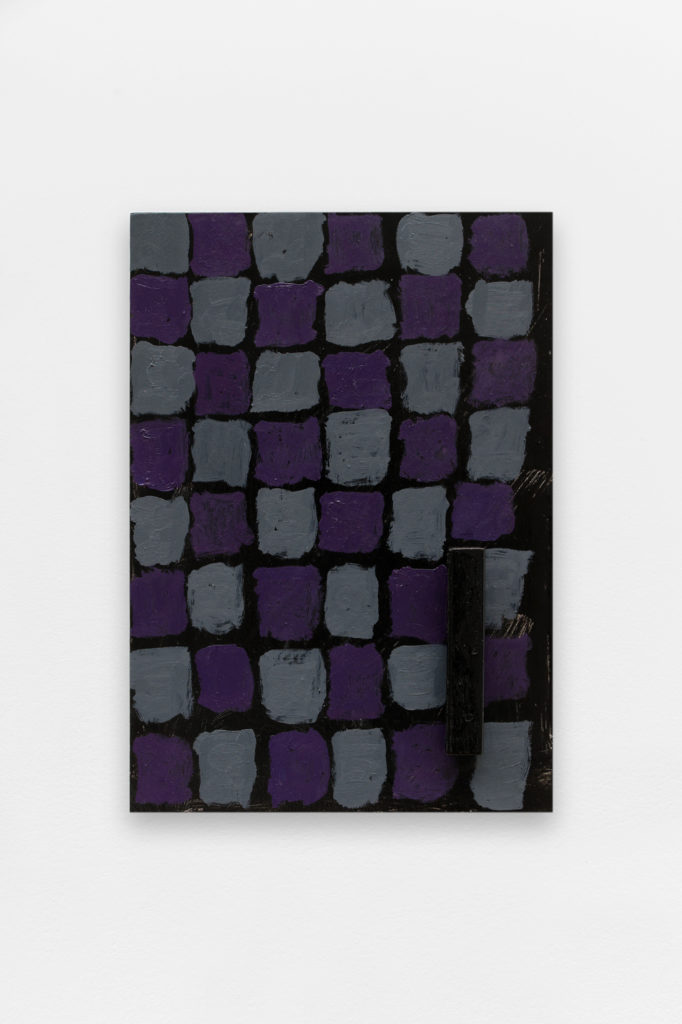
Jordan Derrien
Every cup, 2021
peinture métal, peinture à l’huile, bois, poignée
30 x 20 cm
/////////
Jordan Derrien
Born in 1994, Caen. Lives and works between London and Caen.
Jordan Derrien began by studying industrial design in Switzerland at École Cantonale d’Art de Lausanne (ECAL) before continuing his studies in France, at École Supérieure des Arts & Médias de Caen / Cherbourg and at École Nationale Supérieure des Beaux-arts de Lyon (ENSBA).
Multidisciplinary, Jordan Derrien’s practice maintains a close link between painting and sculpture. The artist develops within his work a permeable and reversible relationship between the inside and the outside, the similar and the identical, the public and the private. Intimate, his work invests a form of domesticity and redefines our relationship to liminal.
In 2021, he organised Hetton Lawn, an exhibition project that took place in Vienna. Referring to the hometown of Alice Liddell, the inspiration behind Charles Dodgson’s novels, Hetton Lawn explores the links between literature and the visual arts through a common theme and story. From the game of chess to the notion of scale or femininity, the works also introduce the transitional aspect anchored in Dodgson’s novels, exploring the famous mirror in which Alice evolves.
His works have recently been shown in exhibitions such as ASSEMBLE, V.O curations (London, UK, 2022) ; Nous Irons Tous au Paradis, FRAC Normandie (Caen, France, 2021); Fait Divers, Palais des Beaux-arts (Paris, France, 2021); Hetton Lawn, Haus Wien (Vienna, Austria, 2021); HELLO [stockings, shoes, hairpins], ArtLacuna (London, UK, 2021); BONJOUR [the situation is not new], W (Pantin, France, 2021); CBARET ’What Not / Speak Easy, LAXART (Los Angeles, USA, 2019); The Kids were doing a dance called the Mashed Potatoes, Window135 (London, UK, 2019); MN_03 * Speculative Wasteland, Media Naranja (Marseille, France, 2018); SPACE FOR SPARKLING WATER, Swimming Pool (Sofia, Bulgaria, 2018).
His writings and conversations have appeared in various journals and magazines, including INSERT, DailyLazy, Initiales.
Nathalie DU PASQUIER
Nathalie Du Pasquier paints objects that become subjects. By stacking, juxtaposing, and composing, she adjusts and shifts the pre-established order, and shifts the motifs. That is, they each retain their autonomy. The simple idea of one form in front of another creates a succession of planes that become a volume. The shapes are cut out of cardboard, paper, wood, coloured and fixed on the panels by gluing. The play of shadows creates a small theatre of simple shapes. Squares, cubes, circles, discs, parallelepipeds, grids are juxtaposed. Playing on the gap between the levels of representation, the artist invents an alphabet of shapes that never cease to change by being combined. It is also a renewed look at everyday objects, going beyond the art of depicting still life to make them objects, actors of something picturesque with nothing to do with the “genre scene”, in order to rethink the life of things themselves. Here, the image goes beyond the obsolescence of representation, it is matter. The artist thinks of the circuit of motifs that travel and sometimes land on the surface of a painting. It is again the aesthetic point of view of a consideration of literally open painting. Not a panel, a two-dimensional plane, but a volume, whose surfaces pre-exist and are recombined. This corresponds to a position with regard to the history of forms: non-chronological and which thwarts classification or hierarchisation attempts between genres.
When closed, Nathalie Du Pasquier’s Cassone de Lisboa looks like a storage box, for hats, for palettes and paint tubes. Its outer surface is grey with red, a Caput Mortem with white. If the artist says that the shelf is already a painting, the reverse is not true. When the small hook that closes the edges of the panels is popped off, a triptych unfolds. It is a portable three-dimensional painting, which can be hung on the wall and unfolded as desired. Its total span is larger than a body. It can be opened halfway, depending on the mood of the day. Like the altarpieces whose opening was in accordance with the ritual calendar. Here, its proportions would be more those of a reliquary, but the forms are radically prosaic.
/////
Nathalie Du Pasquier
Born in 1957, Bordeaux. Lives and works in Milano.
She worked as a designer as part of the Memphis Group until 1987, producing patterns, textiles, decorated surfaces, and furniture.
Since then, her main focus and passion has been painting. Over the past thirty-five years, Du Pasquier has been intrigued by the relationship between objects and the spaces in which they are installed. This ongoing investigation has manifested in paintings, sculptures, designs, patterns, constructions, carpets, books, and ceramics—constantly acting between the representational and non-representational, the tangible and intangible, reality and imagination, and two- and three-dimensional forms.
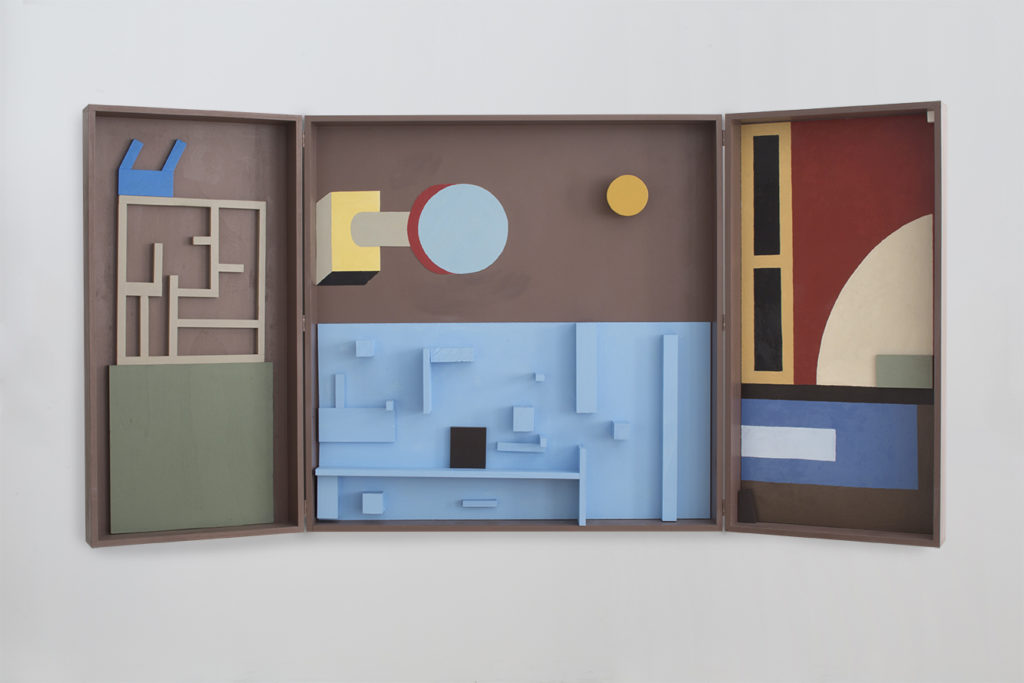
Nathalie du Pasquier
Cassone per Lisbona, 2017
acrylic on wood
100 x 100 x 20 cm (close) / 200 x 100 x 20 cm (open)
Cédric ESTURILLO
Turning around the box, an object of desire, on the floor.
It is a painted box, half open, on the floor. Yellow on the outside, red on the inside. Its elliptical shape evokes the capsules of intergalactic spaceships or the corners of American diners of the fifties. If Googie,Doo-Woop or Space Age soft architecture can be some analogical references, it is from a lived experience of these futuristic spaces of the mid-fifties during a stay in California. As an assistant to Michael Mc Millen, an artist who was also the creator of film sets such as Blade Runner or Close Encounters, as well as being trained in the observation of generic spaces in medium-sized French cities, Cédric Esturillo thwarts models to blur hierarchies, notably between crafts and peripheral visual cultures. The artist is part of a post-medium thinking in the sense of what Rosalind Krauss states in Under Blue Cup (2011). That is to say asking again the question of the partition of the arts by categories and corporations. Why are there 9 muses? The contrast between the smooth patina of the envelope and the shiny sheen of the lacquered inner walls creates a tension that echoes the ambivalence of the object’s purpose.
Con-Apt is a semi-functional box that is difficult to open and requires effort. Its weight makes it difficult to move but its lid makes it an object of use. Its assisted, or thwarted, ustensility defies the attempt to classify it (post-ready-made? conceptual?). The definition of conceptual art, according to John Baldessari, being “everything that is not painting”, requires here to turn the page of a linear and teleological history of the arts. To quote J.B., who burned his paintings (Cremation Painting, 1970) in order to “continue to paint, differently”, Cédric Esturillo burns boundaries and periods, providing an indatable and indefinable piece. A painting, a box? The very process of making the piece invokes the aesthetics of re-use and the logic of dreams. Indeed, the artist saw his piece in a dream before making it. It was conceived by assembling fragments of recuperated transport crates. This recycling, whose cutting and assembly method is no longer visible, makes it an object with a “fetish finish” deviated by the non-smooth patina. In this way, it contradicts the fantasized seriality of Minimalism and is more dedicated to a”post-fordite” and vapor wave economy.
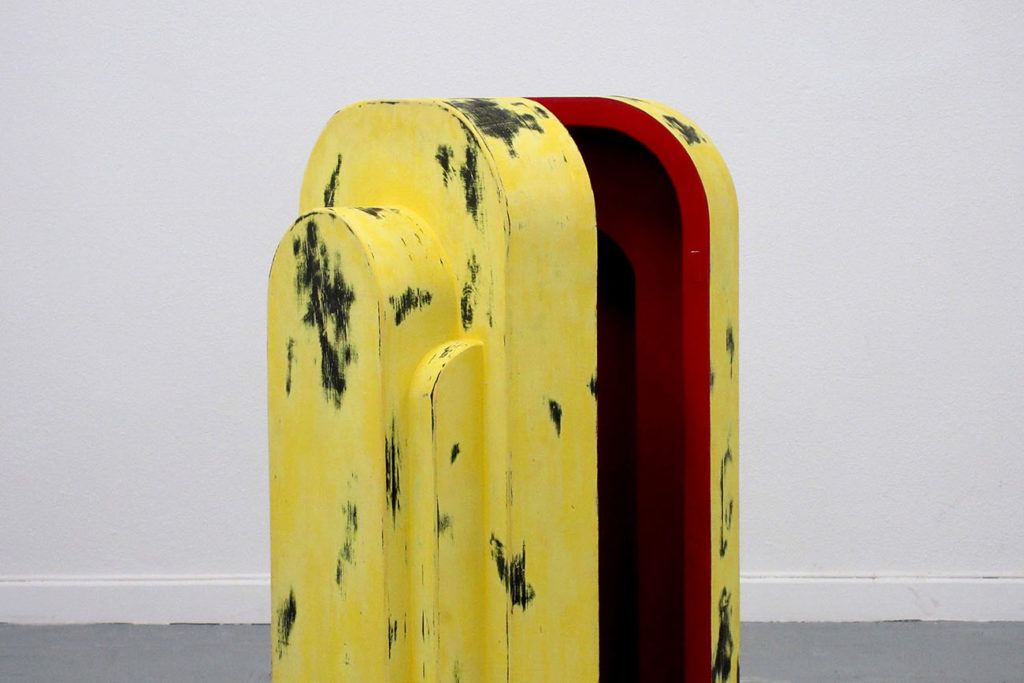
/////////
Cédric Esturillo
Born in 1988, in Saint-Chaumond. Lives and works in Lyon.
Cédric Esturillo constantly moves the object so that it no longer refers to its primary datum. It is therefore a matter of getting out of unique representations, of distorting forms in order to touch the fantasy. It is important for him to produce “subliminal images”. The artist appropriates the codes of popular culture by adding an artisanal dimension. It is an important notion in his work to break down the residual hiatus between craftsmanship and art. He takes care by using wood or the earth of Larnage, used very little, to introduce a durability of the works and even more to be part of a tradition of ancestral know-how. Figures derived from Cédric Esturillo could just as easily be exhibited in a museum of contemporary art, modern art or even Natural History. It is the viewer who makes the work of art, Cédric Esturillo understands this well. As a creator, he brings to it a conscious ambiguity which further strengthens this postulate […]
excerpt from Léa Chauvel-Levy’s text
Guillaume PINARD
Born in 1971, Nantes. Lives and works in Rennes.
An iconoclastic artist who manages to maintain a diversity of styles, Guillaume Pinard reinvents his painting according to the context. He creates spatial settings that modify the perception of the works. This is the result of a series of decisions and actions that summon up the relationship to labour. Here Guillaume Pinard takes the gallery owner’s office as a cassone. A workboxe, places of potential transactions, the space is totally modified by the artist. On the scale of the architecture, Guillaume Pinard installs his own work. He transforms the work space into an amateur cabinet.
The walls are painted in a colour that evokes the appropriate neutrality of open spaces. Reminding us that “box” is also a term for the place of “work”, the artist plays on the double function of a gallery. To put the painting to work is to hang it high enough to make the visitor look up, who in turn becomes active. We look at the paintings from below. The gestures of love are the gestures of work, as Jean-Luc Godard says. In the script of the film Passion, he explains:
“Isn’t the gesture of a female worker like the gesture of the hands of “Ariane, Venus and Bacchus”? (Tintoretto, 1576.) Isn’t life like this Holy Trinity: love, work and something in between?”
From a man who would have liked to film as one paints, is this not a fine tribute to those who also paint and edit? An amateur’s cabinet in an office is a caprice, in the sense of “capriccio”, the term Daniel Arasse uses to talk about Velázquez’s Meninas.
Guillaume Pinard takes liberties with formats, with the formatting of what makes a painting. Playing on the contradiction of the spaces, between the door, the windows and the frames hung side by side, he makes the paint climb up the walls, and the paintings up on the ceiling. Or are the ceiling boxes sliding? Inversion of the meanings, the anagram of “cassoni”, the “caisson” replaces the chest.
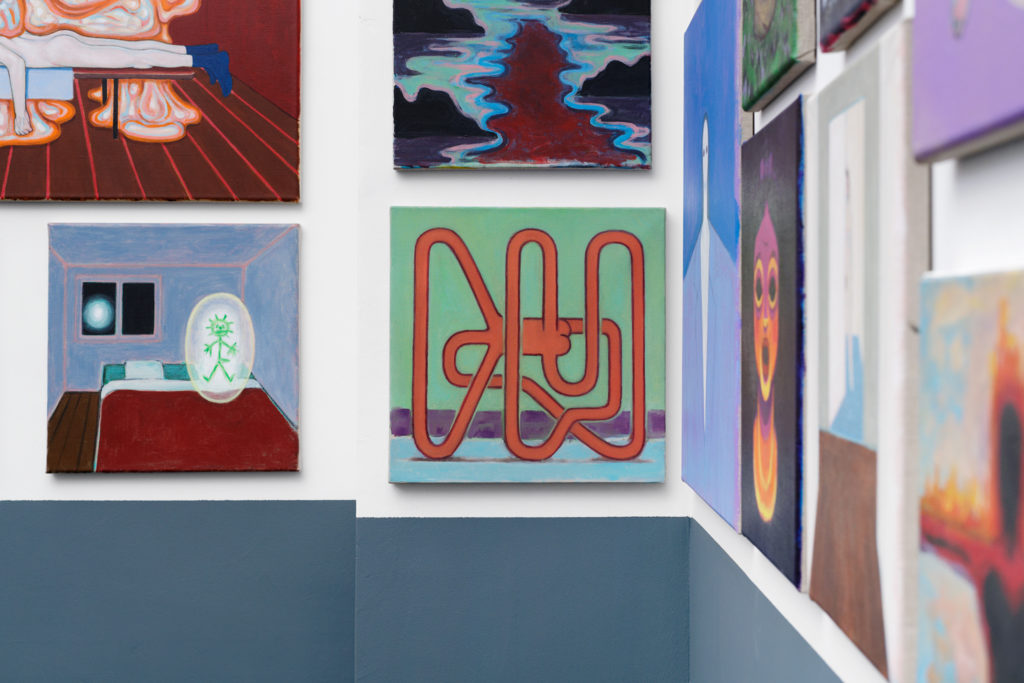 exhibition view, (photo Aurélien Mole), 2022
exhibition view, (photo Aurélien Mole), 2022
Luigi SERAFINI
Born in 1949, in Roma, Italy. He lives and works in Milano.
The box in reliefs, the reliefs in the box. The Cassone-Painting-Universe. The world in a box, in a suitcase…
Luigi Serafini is an outsider artist, a member of the Collège de Pataphysique, the inventor of an illegible but visible alphabet and the creator of the ‘book of books’, the Codex Seraphinianus, an encyclopedia for a world to come. The artist is known for his extraordinary drawings and his furniture and design objects. Recently the translator and scenographer for UBU Roi, he is also a painter. In the manner of Peter Saul, he creates caricatured canvases, political criticism, and thwarts the strategies of fashion. An anti-canonical artist, he reinvents the parable-cassone.
It is a premonitory painting, inviting a virus in 2018, happily ready to go out through the frame.
Indeed, to paraphrase R. Barthes about the cinema, if in life you go out through a door, in painting you go out through the frame. The painting is sculpted in wood, enhanced with gesso and paint. The reliefs hollow out the contours of a giant omelette floating above a grotesque scene. A carnivorous flower seems ready to vomit, while a lion with a halo crosses the street. A tiny darkroom (camera) captures the scene.
One can see a love drama in the manner of Ovid’s Metamorphoses, which the artist holds dear. A contemporary story of Pyramus and Thisbe. The legend tells of two Babylonian lovers, inhabitants of neighboring houses but who have to see each other in secret from their families. The young Thisbe is waiting for her lover but when she sees a lioness with a bloody tail, she flees, leaving her veil behind. When Pyramus arrives, he sees the blood-stained cloth and the tracks of the beast. Believing his fiancée has been devoured, he kills himself. Everything happens at the crossroads of the plant and animal world and the city, at the crossing of a threshold. On the panels of the cassoni, exemplary dramas were depicted. The theme was painted by Nicolas Poussin (Landscape of the Storm with Pyramus and Thisbe, 1651) and revisited by Jutta Koether in 2009, among others. Luigi Serafini is a frequent visitor to the church where Nicolas Poussin’s cenotaph is located, another form of box.

////////
After studying architecture, he composes, between 1976 and 1979, the “Codex Seraphinianus”, a masterpiece, first published, in 1981, by Franco Maria Ricci, and since then republished. “The Book among books”, this encyclopedia of an invented, surrealist and precursory world of a hybrid mankind, where plants, animals and objects combine, is a cult book.
Beyond what is visible and readable, mingling drawings and writing, the work is an inexhaustible source of inspiration. A polymorphous artist, Luigi Serafini works with designers, architects, (…); a painter, a writer, Fellini’s friend, for whom he made the poster of the film “La Voce della Luna (1990), a grand satrap of the College of Pataphysics since 2016, Luigi Serafini is a go-between between a kind of surrealism and the Beat Generation poetry, the cabinets of marvels, Proust, Joyce and today’s world of social networks. (…)
In 2021, Luigi Serafini translates and recreates, with Fabio Cherstich, Alfred Jarry’s play “Ubu Roi”, published in 1886.
An excerpt of a text written by Marie de Brugerolle
Manon VARGAS
Born in 1992, in Suresnes. Lives and works in Nîmes and Paris.
Manon Vargas deals with post-performance painting, intermingling snapshots, collages and animal studies, and playing with different types of focus. It is not a collage but a furious collection. The tension she produces in the field of painting makes her lose her autonomy, she implodes it. Modernism refracted everything and incorporated it as the “subject of painting”; Vargas diffracts painting, which becomes porous to the non-pictorial object (i.e. the format, texture and form of painting are affected and modified by exogenous practices such as film, video games, the making of movable objects).
In this way, she does not translate the world around her into paint, but modifies the pictorial act through its other relationships. To paint is to collect, to gather in the sense of “loot”, to find heterogeneous sources (cinema, video games, furniture), to externalise, to dive for finding colours in wider palettes, to deceive our attempts towards a unique and immediate satisfaction of taste. From the bric-a-brac of our visual culture, she breaks the curse: painting is not just a flat surface. The suspension of disbelief is a second-hand exercise, not given at the outset, ready to be swallowed. One doubts what one sees, and then adheres to it. Video games, animality, cinema are elements that put in crisis the knowledge of Vargas’ painting, replayed in each piece. How do we look at painting?
The artist proposes a contemporary cassone made in a handcrafted way, against the current of the ready-to-assemble mass industry. The piece is unique, a masterpiece of cabinet making in the traditional sense. Its proportion is designed to fit the artist’s body. Unlike the heavy cassoni of old, it can be worn by a young woman alone. The iconography includes all the traditional themes of the wedding chest, adapted to our early 21st century. The nude has slipped to the top of the chest, and the subject of desire is a young man. Inside, on all sides, sides and bottom, the ornamental motifs are repeated: pastillages, checks, lines in a contemporary, embodied interpretation.

Manon Vargas
untitled, 2021
acrylic on wood
98 x 65 x 40 cm (open) / 69 x 64 x 36,5 cm (close)
//////
Manon Vargas showed her work in 2016 during her Artagon II selection, then in galleries in Paris, Lausanne (2018), Creux de l’Enfer or even DOC! during collective exhibitions. The film Château co-produced with S. Gouttenoire was shown at FID in Marseille. She also produced a monumental 412m painting for a public commission from SNCF Réseau in Lyon. More recently she participated in the Prix de Peinture de Novembre in Vitry. Currently she is making a film, made possible due to an individual creation grant.
Manon Vargas is interested in painting as an object. Object of curiosity, Object / Subject, the painting as an object, the objects of the paintings. Painting and its supports become ideal spaces for making ecosystems where a set of disparate elements live, interlock and support each other. Her work results from an interest and curiosity to confront different forms, different ways of painting, different intentions as well as a multitude of representations in painting.
The object, the living thing, and the space can each time be brought together in the same painting space.
The objects are often taken from everyday life and suitable to represent the man who never appears as a figure. Living things come from animals or plants. Space is often not represented by perspective. It is born from the layers of paint between them, from the superimpositions of pictorial elements and sometimes it is even evoked only by the pictorial unity that contains it.
